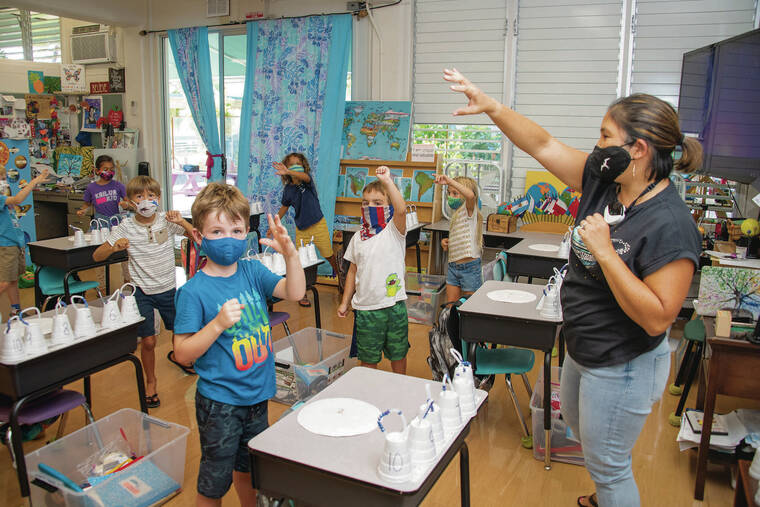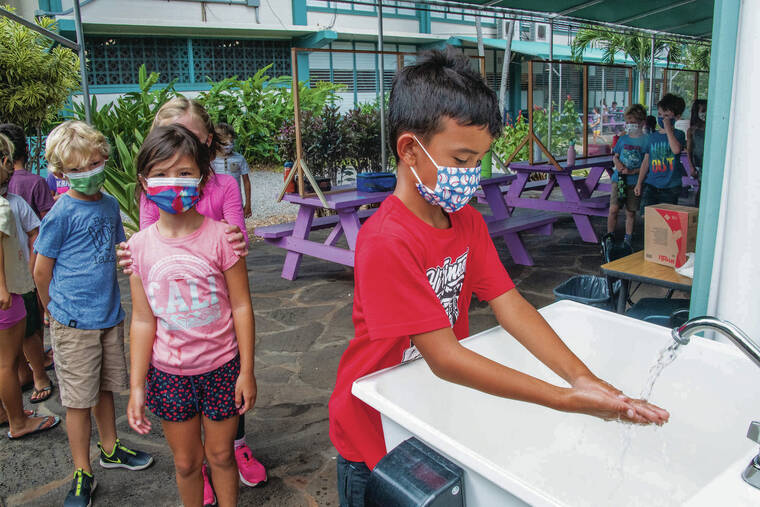Hawaii charter schools more nimble in handling pandemic problems

CRAIG T. KOJIMA / CKOJIMA@STARADVERTISER.COM
Shelly Ciano led her class in exercises Friday at Ka‘ohao Charter School in Lanikai.

CRAIG T. KOJIMA / CKOJIMA@STARADVERTISER.COM
Students lined up to wash their hands Friday after returning from the playground at Ka‘ohao Charter School in Lanikai.


The state Department of Education’s 257 public schools continue to keep their doors open for in-person learning even as COVID-19 surges across the islands and infections linked to campuses continue to rise.
By contrast, many of the state’s public charter schools have taken a different approach, with at least seven schools having shut down on a temporary basis and others quarantining entire classrooms or even grade levels in response to coronavirus cases among students and staff.
While infections linked to the DOE campuses have roughly averaged more than eight per school since July, the 37 public charter schools have averaged nearly three per school.
“The key is our schools are able to respond quicker, and if it spreads, they’re able to make adjustments faster,” said PJ Foehr, interim deputy director of the State Public Charter School Commission. “I feel bad for the DOE at times, because for them it’s all or nothing.”
Most charter schools are smaller, Foehr said, and therefore it’s easier for campuses to cope with the pandemic. DOE schools have a statewide enrollment of nearly 160,000 compared to the charters with just over 12,000. The largest DOE school has over 3,000 students, while the largest charter school is less than half that size.
The charter schools follow the same health guidelines and protocols recommended by state Department of Health and followed by the DOE. That includes having students wear masks, wash their hands frequently, stay home when sick and get vaccinated if eligible.
Don't miss out on what's happening!
Stay in touch with breaking news, as it happens, conveniently in your email inbox. It's FREE!
But each charter school’s governing board determines how and when instruction will be delivered, and can move quickly to change modes of learning.
“Each charter school has the autonomy to decide what is best for their school community when dealing with COVID-19 cases,” State Public Charter School Commission spokeswoman Sheryl Turbeville said.
At the onset of the pandemic in early 2020, the commission granted temporary authorization to all charter schools to provide whichever mode of education — in-person, blended, distance — they are able to safely provide given the level of COVID-19 infections in their respective counties.
Then, on May 13, when the pandemic appeared to be waning in Hawaii, the commission urged charter schools to plan to return to their original model of learning. But the panel also recognized that uncertainties existed about what the situation might be in the fall, and it extended the temporary authorization for another school year.
Ka‘ohao Public Charter School in Lanikai started out offering in-person learning to its 330 students when classes resumed in August after fending off the virus successfully for much of the last school year.
But four cases appeared almost immediately that first week.
After investigating the cluster and verifying the information with the Health Department, the school ordered entire classes and affected employees to quarantine for 10 days — five school days sandwiched between two weekends — since the last time the positive cases were on campus.
Director Winston Sakarai said the school community was notified in an email and the classrooms were cleaned and disinfected. Faculty and staff prepared lesson plans for remote learning and arranged for iPads and materials to be picked up in a drive-thru manner.
“Teachers conducted virtual classes for the five school days of the quarantine period,” Sakarai said. “We evaluated our mitigation strategies and put out a call to our community to help slow the spread of COVID-19, which was well- received and supported. Students returned the following week of school and we have not had any cases since.”
Both of the charter schools on the hard-hit Waianae Coast have temporarily switched to full distance learning. The area has one of the lowest COVID-19 vaccination rates in the state and is one of the state’s leaders in infections.
Following the discovery of several COVID-19 infections at Kamaile Academy Public Charter School, Principal Paul Kepka informed parents Aug. 16 that the school would have to temporarily abandon its in- person learning in favor of learning at home.
“We are very concerned about the number of students who are needing to quarantine at home as well as the increased potential for COVID-19 spread on campus,” Kepka said in a letter. “As a result, Kamaile will pivot instructionally and will be temporarily suspending in-person learning for the next few weeks until the COVID spread slows within our Wai‘anae community.”
On Friday, Kepka said the school plans to phase half of its 919 students back to campus starting Sept. 13.
At Connections Public Charter School in Hilo, the year started with most of its 360 students receiving in-person learning following a successful full year of on-campus instruction. A remote program also was offered to those who preferred to isolate.
Two weeks into the new year, school officials learned of a COVID-19 infection on campus. Then two more emerged.
Protocols established by the school’s governing board called for a 10-day transition to distance learning for the entire school.
Principal Romeo Garcia said that was important for Connections because the entire school exists within one building, there are multiple siblings among the students and a high likelihood of spreading the virus.
“For us, if there’s one case, there could possibly be more, the way the school is configured,” Garcia said. “It’s fortunate we’re a small school. It’s easier to manage.”
Connections is now operating on a hybrid schedule, with only two days of in- person learning.
“It helps to reduce the number of students that could be exposed,” Garcia explained.
The hybrid schedule is anticipated to last through the end of December. “We’ll evaluate it at that point and try to determine what is safe and healthy for the school,” he said.
Garcia said communication with parents is essential. Having a plan that allows for adjustments when it makes sense is key as well, he said.



